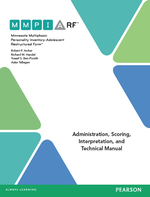MMPI-A-RF Expert Interviews
Meet the Author
MMPI-A-RF co-author Robert Archer, Ph.D. shares details about his background in adolescent psychology and the development of this brand new test.

How did you first get involved in adolescent psychology?
During my internship at the Medical University of South Carolina, I rotated onto an adolescent inpatient unit and became involved in conducting psychological assessments of adolescents. As I began to use the MMPI with this age group, I realized that very little was known concerning how to use the test with adolescents. I started doing research to evaluate the effects of different norms on test results with teenagers, and this developed into the primary focus of my research across the past 40 years, i.e, the identification of the unique aspects of adolescents’ responses to the MMPI.
What are the three most important things that people should know about the MMPI-A-RF?
First, that the MMPI-A-RF is heavily informed by the MMPI-2-RF and represents an adaptation of this instrument for use with adolescents. However, the MMPI-A-RF also contains a number of validity and substantive scales that were uniquely designed to address issues related to adolescent development and psychopathology. Second, the MMPI-A-RF is an empirically supported test with extensive reliability and validity data. For example, the MMPI-A-RF Manual provides over 17,000 correlations between MMPI-A-RF scale scores and external criteria in a variety of adolescent samples. Finally, I think that test users will appreciate the 241-item length of the MMPI-A-RF, particularly because it may make adolescents more willing to complete a broad-band self-report personality assessment instrument. The 241 items are a subset of the 478-item MMPI-A booklet.
What was the primary goal in developing the MMPI-A-RF?
The central objective in the development of the MMPI-A-RF was to improve on the discriminant validity of the MMPI-A by reducing the ubiquitous and confounding influence of the demoralization factor commonly found in most personality inventories and the extensive item overlap across the MMPI-A scales. The MMPI-A-RF was created to reduce the redundancy found among MMPI-A scales by isolating the demoralization factor and reducing its influence on the “seed” or “core” components of the MMPI-A-RF scales. This process resulted in shorter scales (in contrast to their MMPI-A counterparts) with comparable convergent validity but improved discriminant validity.
What advantages does the MMPI-A-RF offer over other adolescent assessment instruments? How do you see the MMPI-A-RF most benefiting today’s adolescents?
The MMPI-A-RF is an empirically based personality assessment measure for use with adolescents that was developed using current models of psychopathology and personality. The test features 48 empirically validated substantive scales and six validity scales relevant for use with adolescents in a variety of clinical, forensic, medical, and school settings. It is anticipated that the MMPI-A-RF will rapidly become a dominant measure of adolescent psychopathology, widely used in diagnosis, treatment planning, and treatment outcome evaluations.
Additional information on MMPI-A-RF product offerings and training opportunities can be found here.






